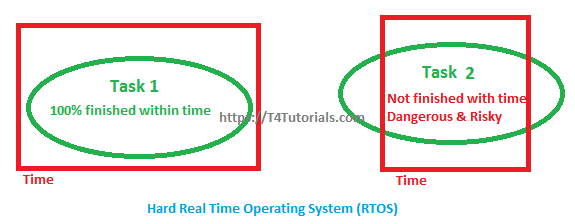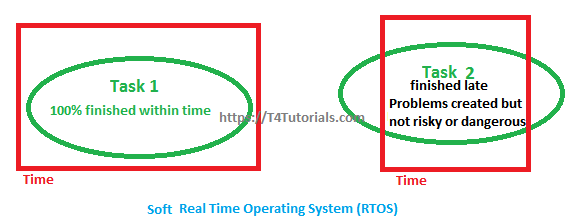Real-Time Operating Systems – Hard VS Soft RTOS
Real-time operating systems are specially designed to strictly follow the time limits. The actual focus of the real-time operating system is to complete the given task within the time limits.
Examples of real-time operating systems
- The operating system of the microwave oven.
- The operating system of the Washing machine.
- The operating system of the airplane.
- The operating system of digital cameras and many more.
The quick response of the process is a must in real-time operating systems. There is no chance of any kind of delay for the completion of any process. A little delay can cause several dangerous issues.
If we see the example of real-time operating systems in our daily life, then we can see that our brain works like a real-time operating system. If you
see that a truck is coming towards you with a high speed, then you quickly Move your car to another direction. in this example, while you are driving, you are brain works like a real-time operating system.
Types of Real-Time systems
There are two main types of real-time operating systems;
- Hard real-time operating systems
- Soft real-time operating systems
Hard real-time operating systems
Hard real-time operating systems strictly and most strictly follows the time. Here, strictly means most strictly. A little delay can cause breakdown is the failure of the real-time operating systems. Now let’s see the examples of real-time operating systems;
- The real-time operating system for ICU in hospitals
- The Real-time operating systems for military weapons
- The real-time operating system for missile systems
- The Real-time operating systems for airplanes
- The real-time operating systems for fire extinguisher

Soft real-time operating systems
Some real-time operating systems watch just like the hard real-time operating system. the only difference is that hard real-time operating system strictly and most strictly follows the time, while soft Real Time systems are not so much strict like a hard real-time operating system.

it means that if a customer comes and ask us to develop a real-time operating system, then we can ask him/her that he/she requires a soft real-time operating system are hard real-time operating system. The cost of a hard real-time operating system is higher than the soft real-time operating system.
Suppose we give a task to the soft real-time operating systems, and the operating system failed to complete the task within the given time, then, in this case, real-time systems reschedule the task and again try to complete the task.
Soft real-time operating systems can have a big task ok that is a mixture of real-time task ok and non-real time task. In this case, the priority for process execution will be given to the real-time task. When the real-time task will complete the operating system allows the non-real time task to complete its execution. Today most of the operating systems are the real-time operating system just like Linux.
Advantages of Real-Rime operating systems
Task switching
Real-time operating systems are designed in such a way that starts switching is a very quick process. Normal traditional operating systems takes a lot of time while switching from one person to another process. The real-time operating system complete the task switching only within some of the microseconds.
Focus execution
The main focus of real-time operating systems is to handle the task in execution, and just a little focus is on the task in waiting.
Approximately Error free
Real-time operating systems are designed very carefully. https://t4tutorials.com/types-of-software-testing/ Different kinds of software testing techniques are applied to the real-time operating system to test the system. This detailed testing makes the real-time operating system approximately error-free.
Maximum resource utilization
Real-time operating systems are designed to secretly follow the task within a given time. This is not simple and easy to complete the task within time. The real-time operating system utilizes all the hardware efficiently and completely. The main focus of the real-time operating system is not to save energy or resources. So we can see that the real-time operating system utilize the resources completely and very efficiently.
Usage in embedded systems
Real-time operating systems can also work with embedded systems.
All-time performance
Real-time operating systems are designed to works for 24 hours a day and every day.